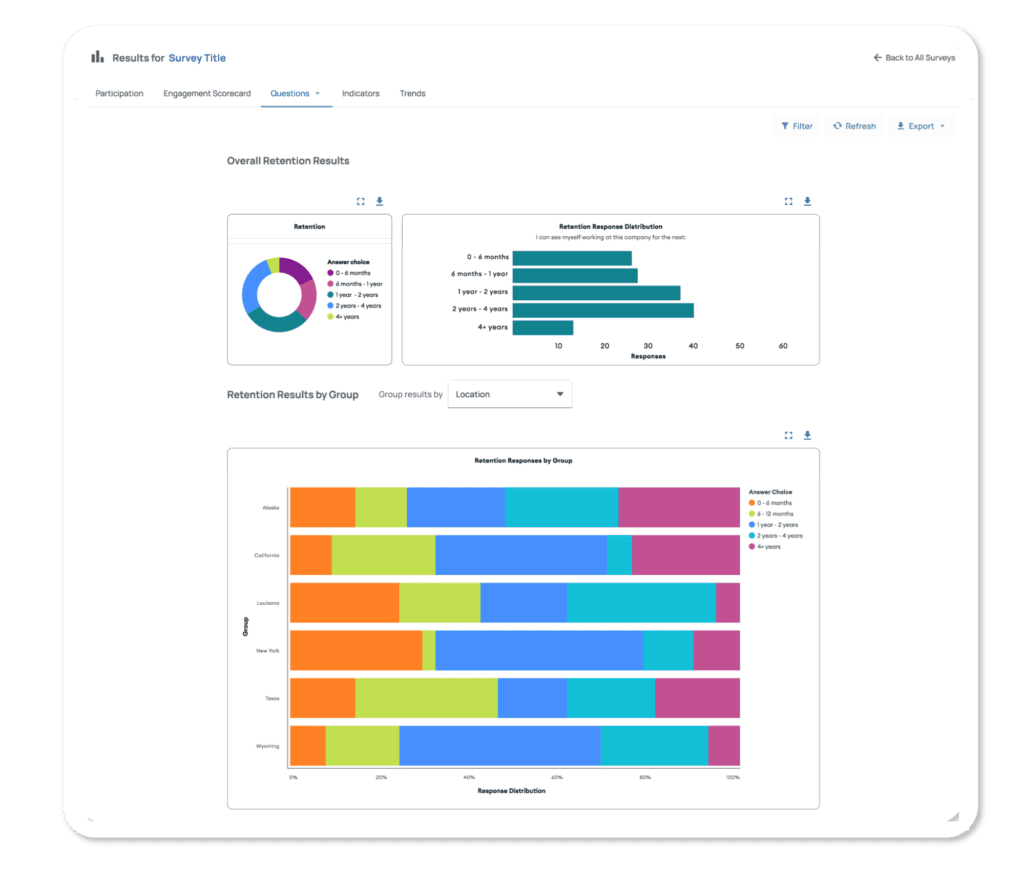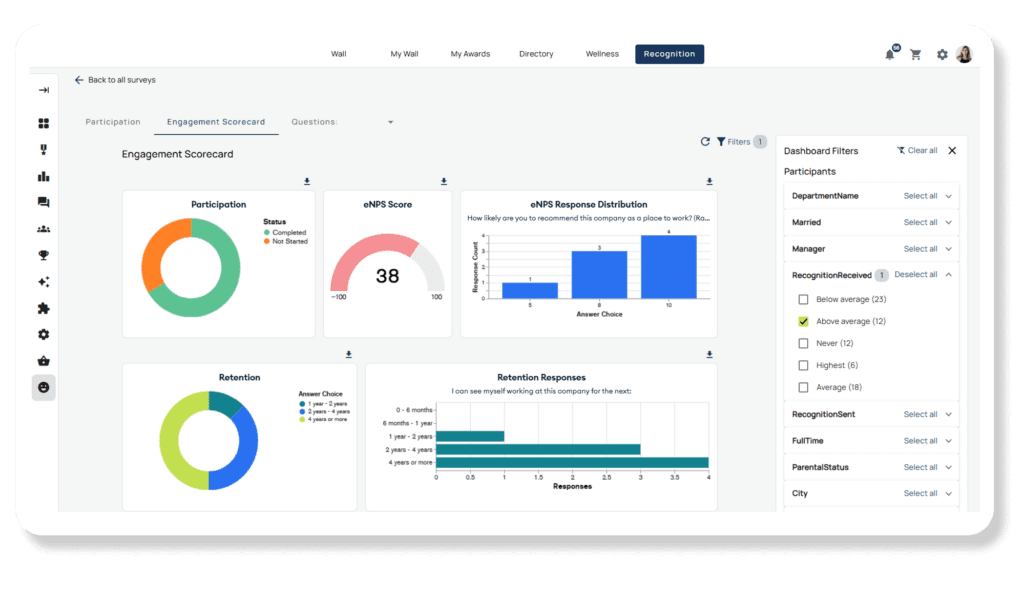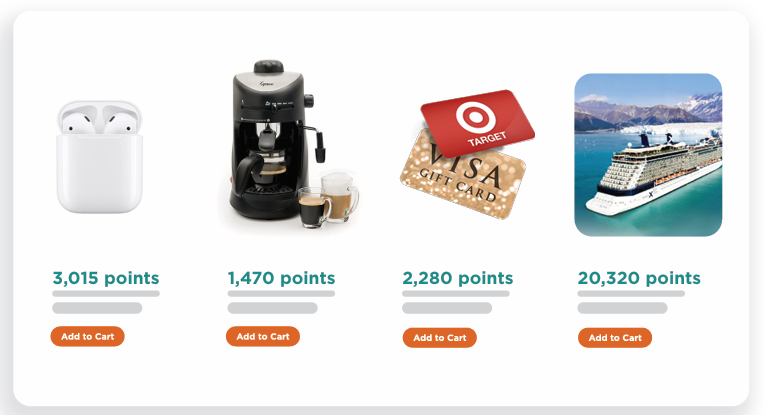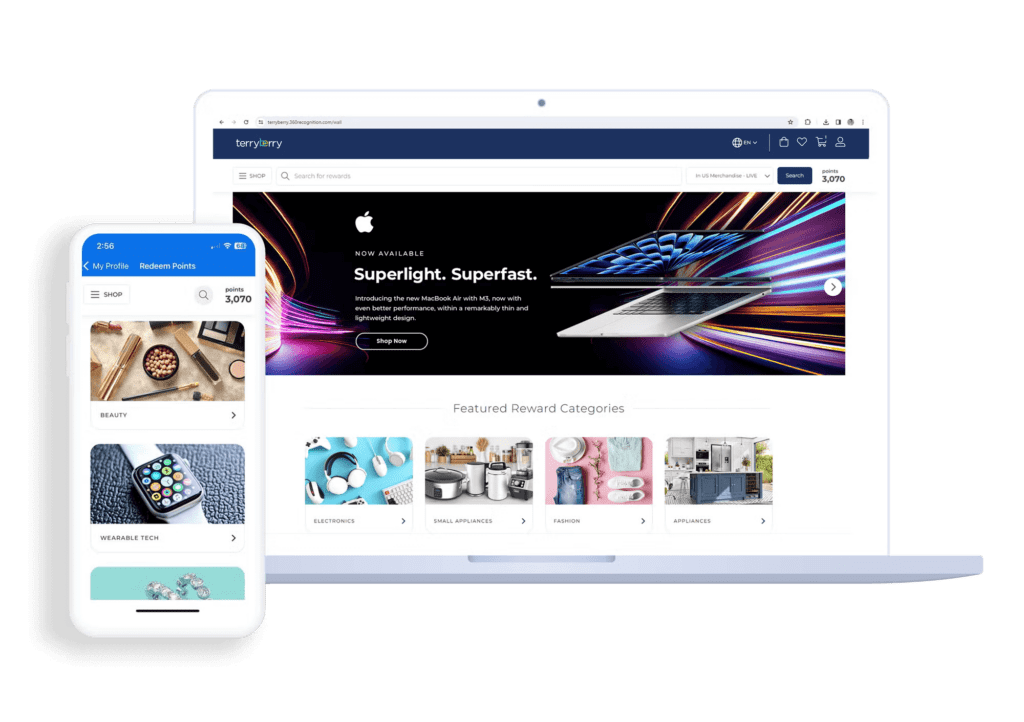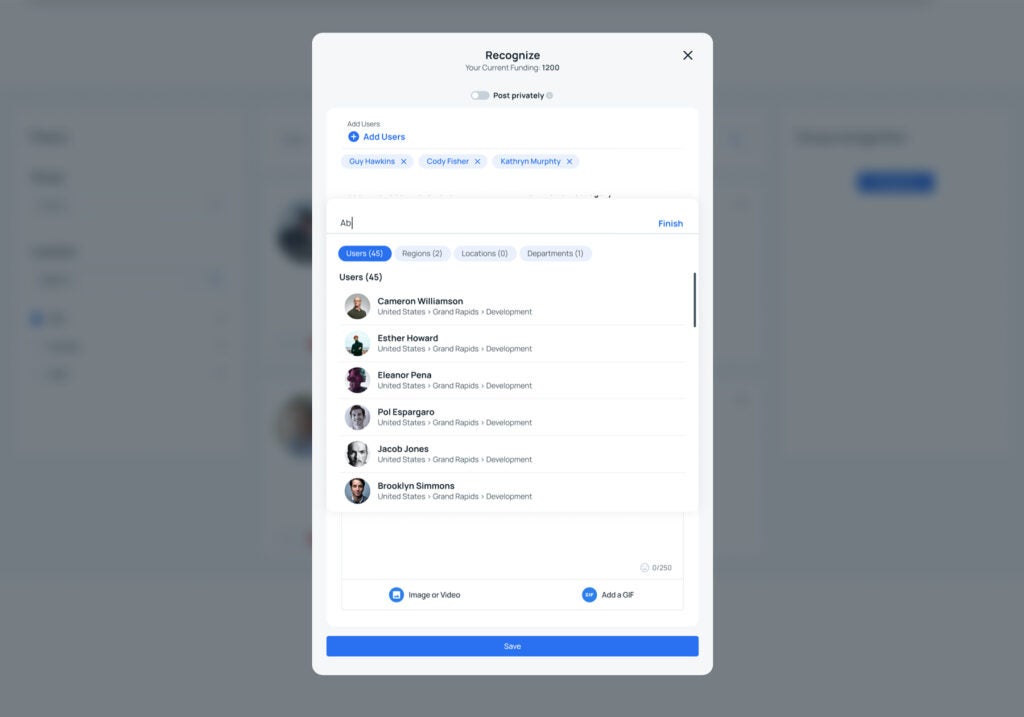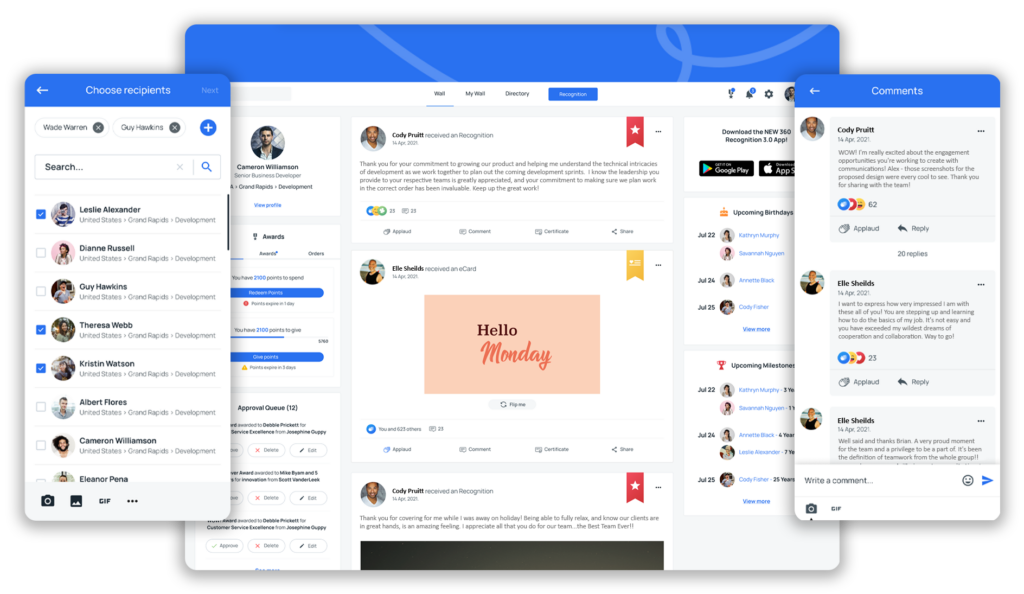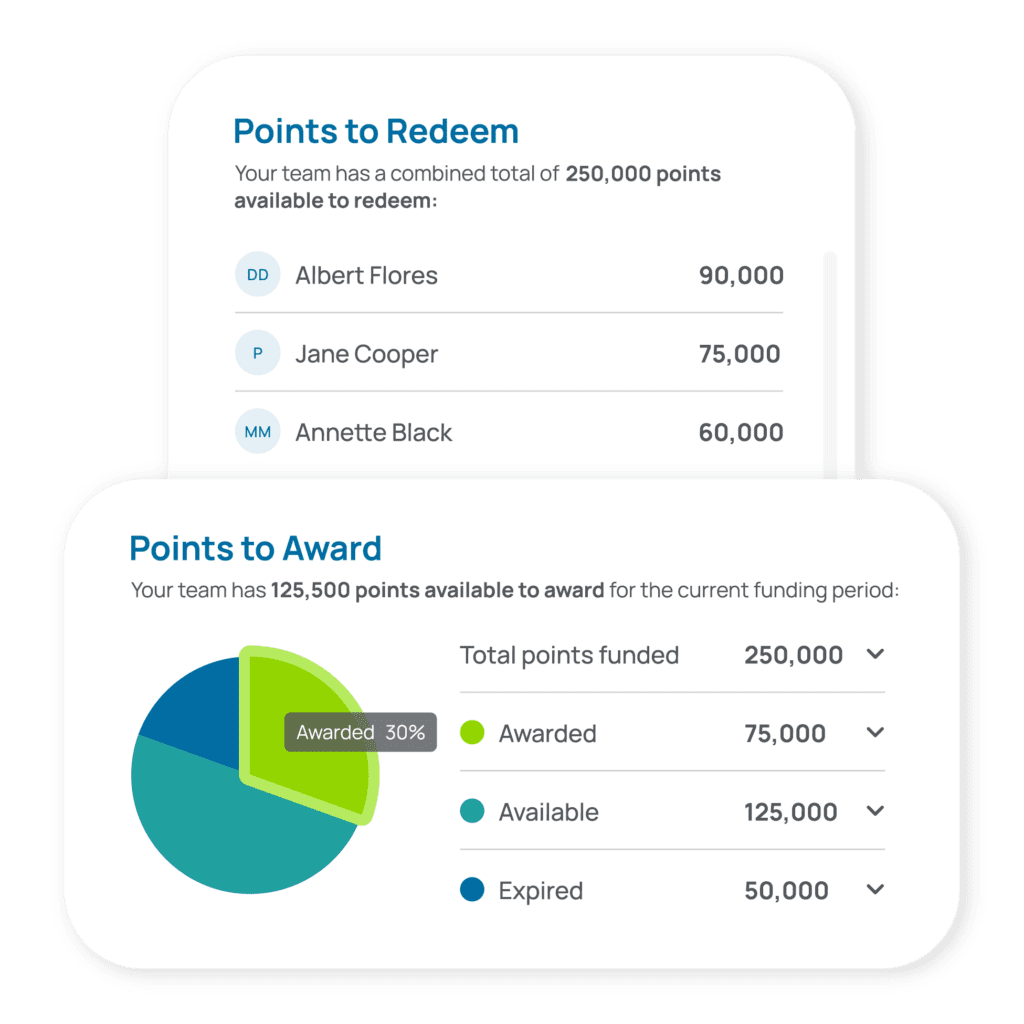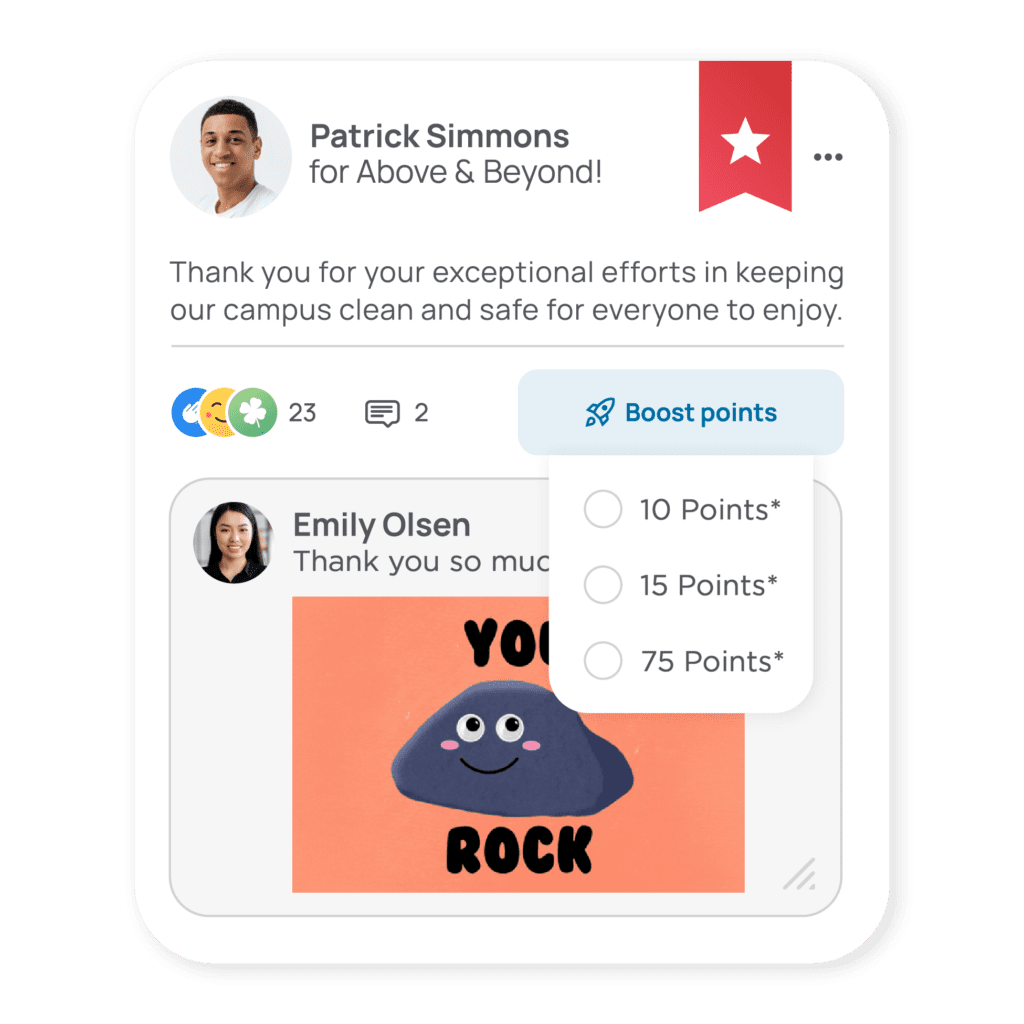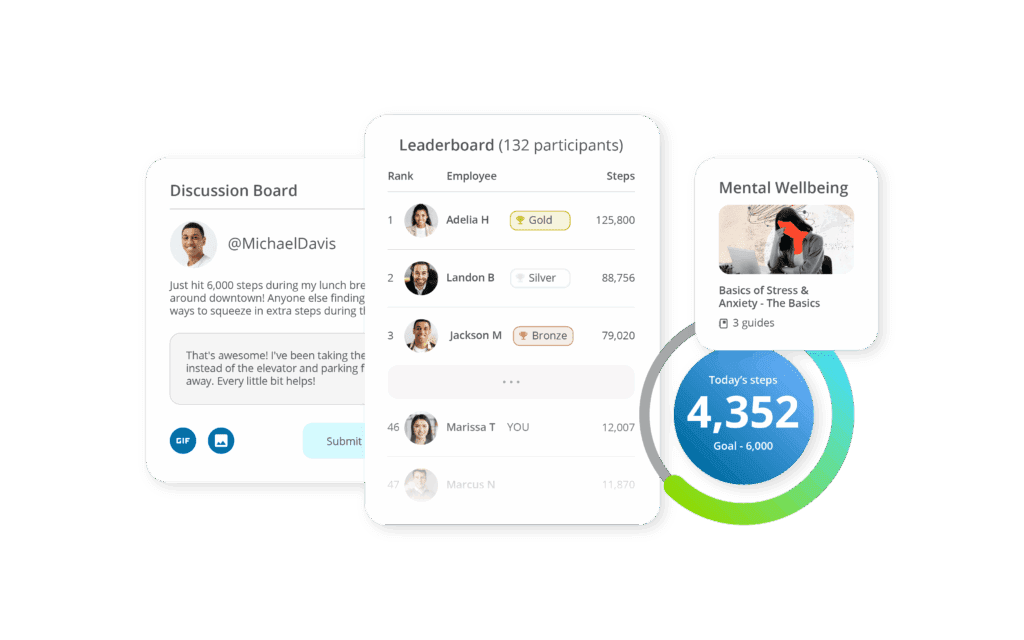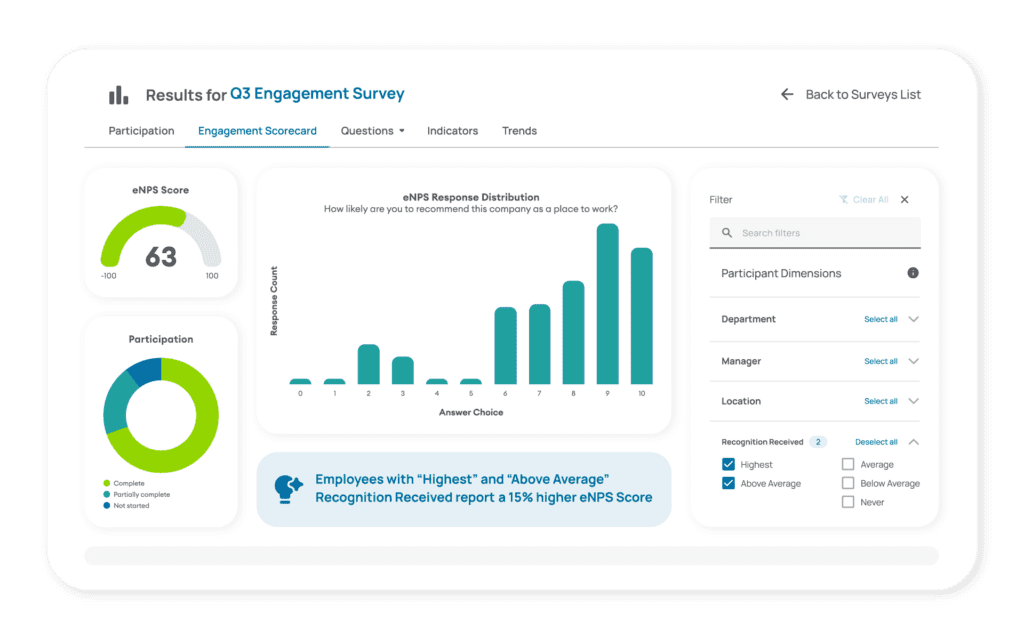October 24, 2025

The right employee engagement software for the legal industry should:
a. Help you identify and address specific engagement challenges in your organization.
The legal industry shares some common factors that negatively impact engagement & retention, ranging from fatigue and burnout connected with high-pressure working environments to limited growth opportunities and high churn amongst junior employees.
Taking action requires identifying the challenges that specifically affect segments of your workforce. For example, maybe paralegals feel a stronger sense of belonging and empowerment than junior partners. Some age groups may value work-from-home options more than others.
b. Support the unique setup and working environment of law firms.
One-size-fits-all engagement programs don’t typically translate well to law firms due to:
- Workforce structures: Legal organizations have various professionals with complex hierarchical and reporting structures. Any program you design has to engage each group and address their unique needs.
- Cultural considerations: Legal workforces are primarily focused on servicing clients, leaving them with less time and mental space for internal initiatives. Many firms also have high-pressure cultures, and changing them isn’t always straightforward. Is leadership ready to deprioritize “billable hours” as a strategic objective?
For these reasons, law firms have to develop and launch engagement programs tailored to these setups. You’ll also need a platform that supports these programs with the right configurations; e.g., one that lets you balance different strategic objectives and tailor programs to specific departments, job titles, and seniority levels.
Depending on your organization’s needs, you might require multiple tools to drive engagement. Here’s an overview of the 5 main types of tools to consider:
- Employee listening: The right employee listening tool uses science-backed engagement surveys to measure and quantify engagement across your organization. It also clarifies which tools you’ll need next (e.g., a wellness platform if your team struggles with physical or mental well-being) and helps you identify which groups are churn risks (e.g., associates with 2 years of tenure) and the well-being of different groups (e.g., junior partners more prone to burnout than seniors).
- Employee rewards & recognition software: Ideal for recognizing and rewarding employees for specific actions, outcomes, and milestones. For example, you can recognize employees for their years of service and reward them for demonstrating your organization’s core values.
- Employee wellness tools: Support employees’ physical, mental, and workplace well-being.
- Professional learning & development platforms (L&D): Onboard new hires, upskill existing employees, and support career progression.
- Career planning & performance management tools: Empower legal professionals with personalized career paths and measurable goals.
In a Hurry? Here Are The 5 Platforms We’ve Reviewed
In the following sections, we’ll cover:
- Terryberry: Our employee engagement software for the legal industry that combines employee listening, recognition & rewards, and wellness tools in one platform. We’ll show you how law firms use it to quantify engagement, take action with tailored strategies, and build a business case for their programs with deep analytics. We’ll also highlight engagement programs that support specific objectives—such as reducing burnout, promoting core values, and increasing retention.
- Vi by Aderant: a complete people management solution for legal teams with a native CLE LMS.
- PerformYard: a standalone employee performance management tool used across various industries, including legal.
- Litera: a legal technology solutions provider with recruiting, onboarding, performance management, financial management tools, and more.
- BigHand: a Litera alternative with resource management and productivity tools for legal teams.
1. Terryberry’s Highly Configurable Employee Engagement Software for the Legal Industry
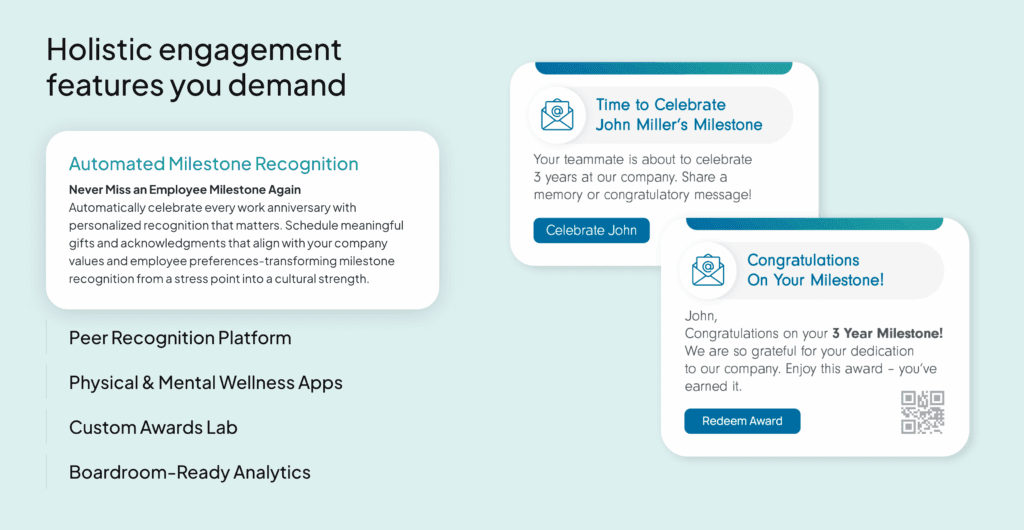
Terryberry lets you launch tailored employee listening, recognition, incentive, and wellness programs in a single, centralized engagement platform. Here’s how Terryberry is uniquely designed to support law firms:
- Tailored programs to match strategic objectives: We can customize nominations, approvals, and milestones to reward and recognize actions and outcomes. For example, you could recognize employees for demonstrating core values in their day-to-day, or reward employees who accumulate the most billable hours each quarter.
- Centralized analytics with cohort analysis: Terryberry combines data from across all of your programs to help you measure their impact on employee engagement, retention, and each other. You can break the analytics down using specific filters—such as department, job title, seniority, tenure—to measure engagement across specific groups and uncover trends.
- Tools to maximize participation: We bring your engagement programs directly to busy employees and attorneys-on-the-go, with desktop and mobile applications, integrations with MS Teams and Outlook, and offline surveys, rewards, and recognition options. Terryberry’s integrated rewards platform also lets you add incentives from the largest selection of rewards on the market, motivating teams to participate in your programs.
- Complete visibility into program budgets and spend: Terryberry tracks expenditures across all your engagement programs in real-time, making it easy for program leaders to see how much of the allocated budgets are consumed.
In the next three sections, we’ll show you how to:
- Benchmark employee engagement and retention in your organization, and uncover actionable insights that inform your engagement strategy. Find out which factors keep your workforce engaged—and which are standing in your way.
- Configure and launch engagement programs tailored to your strategic objectives. Whether you’re looking to promote core values, fight burnout, or recognize people for their years of service, we’ll tailor Terryberry to meet your team’s needs.
- Prove your program’s impact to leadership. Terryberry’s centralized analytics measure and quantify the impact of your programs on employee engagement, retention, and each other. Easily generate leadership-ready reports and make a strong case for your programs.
I. Employee Listening: Investigate the Factors Impacting Turnover and Engagement
Terryberry’s employee listening tool combines science-backed surveys and powerful analytics to help you capture employee sentiments, quantify engagement, and predict churn. Our library includes dozens of ready-made surveys for measuring different employee sentiments—including those towards leaders and peers, initiatives and policies, aspects of their jobs, and more.
You can uncover deeper insights by combining the results from different surveys—such as eNPS and engagement—and other engagement programs (such as recognition). For example, let’s say you want to identify (1) which groups are most prone to churn, and (2) the factors that contribute to their potential attrition.
First, you’d run employee Net Promoter Score (eNPS) across your organization to measure employee satisfaction, loyalty, and engagement. We’ll help you maximize responses for these surveys by making them readily available to all your employees—via mobile app, desktop, QR code, custom links, or even physical paper. After conducting the surveys, Terryberry processes the results and displays them in an interactive, visual dashboard:
Here, you can filter by location, age, department, job title, tenure, seniority level, manager (i.e., the team members under a manager), and more to spot trends specific to cohorts. For example, you might use the seniority filters to compare retention across different partner levels.
Now, to understand the factors impacting retention across these groups, you can run our engagement baseline survey—developed by three independent PhD researchers and backed by I/O psychologists. The baseline survey is based on Terryberry’s culture model (developed by independent researchers), which uses six indicators to quantify employee engagement and predict retention.
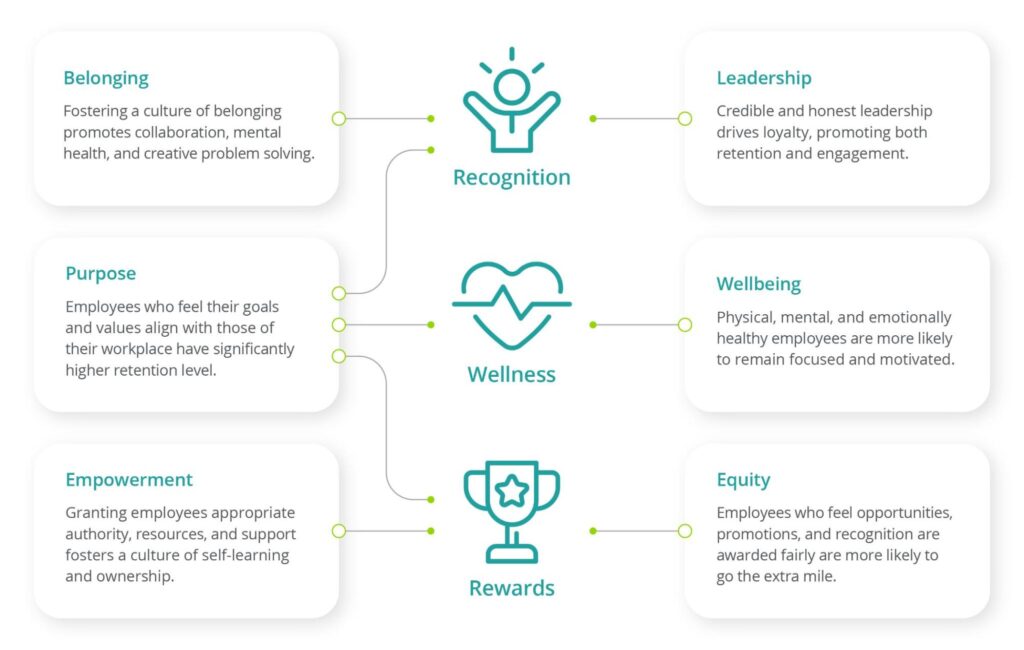
Each of the six indicators—belonging, leadership, equity, purpose, empowerment, and well-being—measures a different aspect of your culture. For example, employees who score high in leadership and purpose are typically more driven, loyal, and likely to stay.
Running the baseline survey returns a set of six Likert scores (which can be positive or negative) that quantify each engagement indicator. For example, a score of +20 in “purpose” suggests employees are strongly aligned with your company’s vision. In contrast, a score of -15 in well-being may indicate underlying challenges that contribute to fatigue and burnout.
Combining results from the eNPS and baseline surveys offers a blueprint for developing your broader engagement strategy. For example, let’s say you analyze eNPS survey results by cohort and discover that senior associates with three years of service are churn risks. Then, you zero in on the engagement baseline results for this group and discover low “empowerment” and “well-being” scores.
Now, you can use additional surveys to dig deeper into the root causes, e.g., using Terryberry’s:
- Burnout and well-being drill-down surveys to investigate why the group’s “well-being” scores are low—i.e., why these team members are struggling with their physical or mental well-being.
- Employee satisfaction and empowerment drill-down surveys to find out why “empowerment” scores are low—i.e., why this group doesn’t feel fully supported in their roles.
Next, you can use cohort analysis to discover trends in employee engagement or investigate the factors impacting specific groups. For example, you can compare:
- “Equity” and “belonging” scores for employees with different tenures to see if they increase or decrease over time. You can also look for trends specific to different segments; for example, associates with 3 years of tenure may have lower “equity” scores than those with 2 or 4 years.
- Well-being scores across different job titles—e.g., paralegals, junior partners, legal secretaries, and IT administrators.
The insights you gather from employee listening will inform your engagement strategy—it will help you decide which programs to use, their objectives, and which groups they’re for.
II. Launch Employee Recognition Programs Tailored to Your Strategic Objectives
Recognition programs are among the most versatile engagement tools, especially for changing workplace culture. They can help you motivate employees to achieve specific outcomes and emphasize both performance and the company's values. For example:
- Milestone programs that recognize employees for billable hours and years of service strike a balance between high performance and loyalty.
- Peer recognition programs instill a shared sense of purpose, increase cross-team visibility, and motivate people to help each other.
You can use Terryberry’s employee recognition software to launch programs tailored to your goals—customizing program objectives, nomination workflows, and approvals.
These features allow you to control:
- What people are recognized for. This could be years of service, performance, or demonstrating core values. Getting these objectives right is crucial because they determine your program’s long-term impact on your culture. For example, recognizing employees for cross-team collaboration can break down unwanted siloes over time. Similarly, rewarding employees for demonstrating core values—such as honesty, integrity, or dedication—shapes people’s daily working dynamics.
- Who can nominate and reward people. For example, peer recognition programs allow employees to recognize their peers’ contributions and nominate them for awards. You can also allocate budgets to managers to use at their discretion.
- The rewards employees have access to. Recognition programs typically reward employees in different ways—for example, you’d spend more on a partner’s 10th year work anniversary than on recognizing a business-as-usual contribution (e.g., meeting a tight deadline). Terryberry’s integrated rewards platform offers two systems for managing these budgets and linking rewards to contributions/outcomes:
- The points system, which is more versatile. With this system, employees are awarded points for their contributions/milestones—e.g., 50 points for demonstrating a core value and 500 points for receiving excellent client feedback. Employees can then exchange these points for rewards via Terryberry’s platform.

The points system lets you assign more importance to some outcomes than others. You can also provide managers with points budgets to use at their discretion—for regular on-the-spot recognition or to buy an employee’s retirement gift.- Recognition levels. The levels system lets you create reward tiers tied to a dollar value—e.g., receiving recognition at level 5 means you can purchase rewards worth $250, while level 6 takes you up to the $300 rewards tier. Law firms typically use the recognition levels system for years-of-service awards programs and performance programs (such as billable hour milestones).

Our rewards system is integrated with Terryberry’s broader engagement platform, allowing you to add rewards to your programs, create shopping portals, place and track orders, and manage budgets in one place. We offer three categories of rewards:
- Custom awards that we’ve been manufacturing for over 100 years, including trophies, plaques, and jewelry.
- The largest selection of rewards in the market via Amazon Business. Unlock zero-markup rewards and get Prime-like delivery across the U.S. thanks to Terryberry’s integration with Amazon Business (U.S.).
- Terryberry’s Premium Rewards catalog, which lets you mix and match various rewards categories, including electronics, charitable donations, travel, lifestyle, once-in-a-lifetime experiences, merch and more. The Premium Rewards catalog lets you place orders to over 100 countries without paying hefty internal shipping and customs fees, thanks to our partnerships with local fulfillment providers.
Up next, we'll take you through the various types of goal-driven employee engagement programs that you can launch with Terryberry, including manager, peer, and milestone recognition programs, as well as employee wellness initiatives.
Manager Recognition Programs: Empower Partners & Manager Roles to Engage Their Teams
We strongly advocate for a top-down approach to employee engagement; we’ve seen from experience that the most impactful programs are led by leadership and then amplified by regular employees. With Terryberry, you can configure the level of control managers have over recognition, such as:
- Specifying reasons for recognizing employees, such as meeting a tight deadline or demonstrating one of your core values.
- Allowing managers to recognize employees on the spot, entirely at their discretion. This level of control allows managers to reward individuals for novel situations, such as one-off client emergencies.
Terryberry lets you allocate point budgets to managers (e.g., partners, IT director) at fixed periods for them to spend according to your configurations. They can use these budgets for:
- On-the-spot recognition—e.g., when a team member goes above and beyond to support a peer, or when they lead their first client meeting.
- Recognizing performance—e.g., if a team member receives exceptional client feedback, reduces matter hours with a unique approach/workflow, or exceeds revenue targets.
Terryberry’s mobile app makes it easy for managers to recognize employees when they’re on the go, during breaks, and between meetings. These recognition moments are broadcast on the shared culture hub for all to see.
Terryberry’s also offers manager dashboards to track:
- Budgets: including the number of awarded, remaining, and expired points.
- Team recognition: including your most and least recognized employees and top reasons for recognition.
Peer Recognition: Empower Regular Employees To Drive Engagement
Peer recognition programs can help you break down workplace siloes and shape culture by making everyone responsible for employee engagement. For example, let’s say a partner is helped by a colleague who isn’t assigned to their account, or they see a paralegal going above and beyond in their work.
The partner can formally recognize their peers on Terryberry’s shared culture hub, broadcasting the moment for everyone to see. Colleagues can then react to the post, leave comments, and even award the recipient additional points.
Peer recognition programs also help employees appreciate the collective impact of their efforts and teams they may not regularly interact with. For example:
- Partners can see the contributions associates and paralegals make to other cases and teams.
- Client-facing teams can better appreciate the contributions of your behind-the-scenes IT and Ops teams that keep everyday operations running smoothly.
Terryberry supports both on-the-spot peer recognition and nomination-based recognition, such as peer-chosen awards (e.g., “Associate of the Month”) by allowing you to customize:
- Nominations and their workflows: For on-the-spot recognition, you’d simply customize nomination options—e.g., with fixed options such as “cross-team collaboration,” “going above and beyond,” or “demonstrating X core value.” For nomination-based awards, you can require a minimum number of nominations to qualify for an award and have people specify a reason alongside their nomination.
- Approvals: For example, maybe some awards require the managing partner to approve the final section.
Milestone Recognition Programs: Increase Retention and Reward Performance
Milestone programs can support your broader objectives by reinforcing positive outcomes, recognizing loyalty, or simply celebrating your employees. You can configure Terryberry’s recognition software to celebrate various personal and professional milestones, including birthdays, service anniversaries, performance milestones (e.g., most billable hours per quarter), and more.
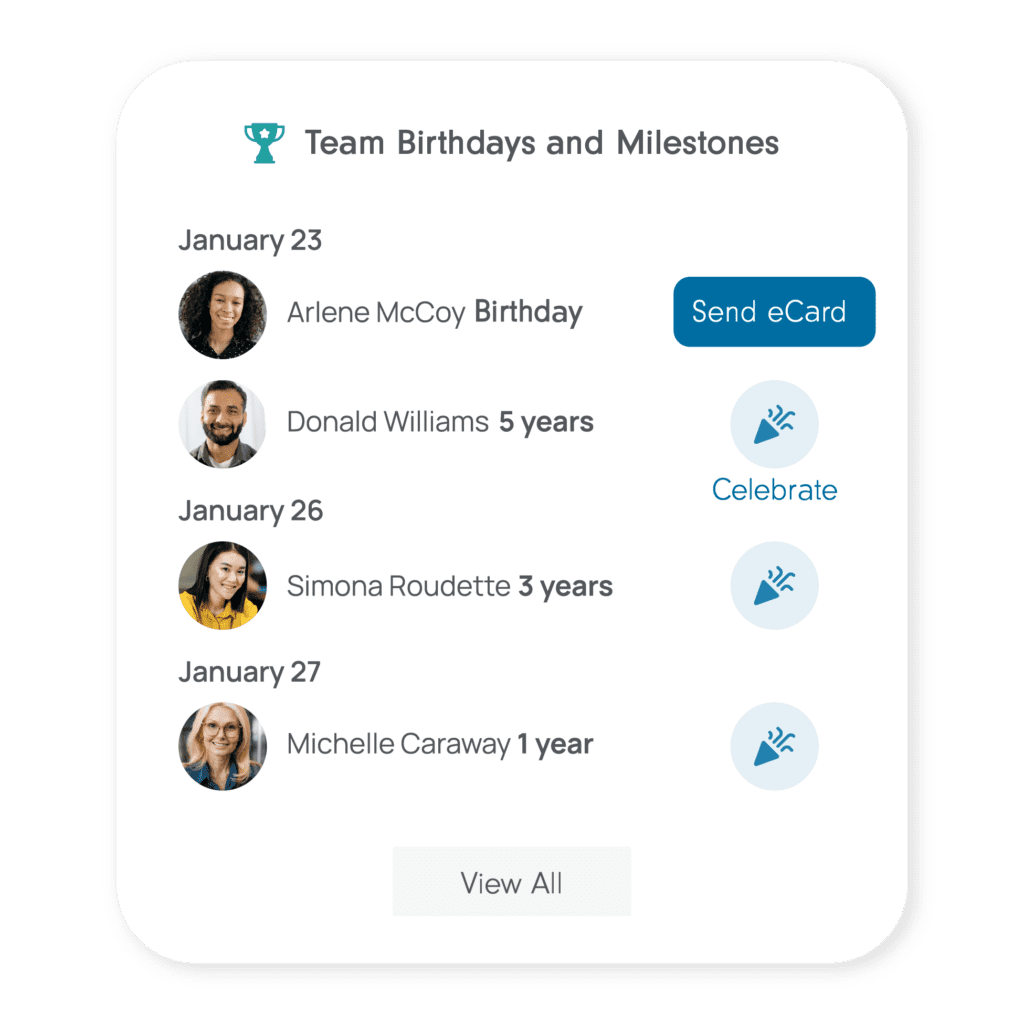
- Years of service awards program to celebrate work anniversaries—e.g., every year or at fixed intervals such as 1, 3, 5, 10, and 15 years of service. You can make these programs more impactful by recognizing the recipient’s contributions and achievements over the years—e.g., for always helping their team members and going above and beyond in their work.
After configuring these milestones in Terryberry, our platform automatically tracks each employee’s service anniversaries using the data pulled from your HRIS. You can also create recognition levels corresponding to each service anniversary, with the best rewards reserved for longer service anniversaries.
- Billable hours milestone program to recognize employees for reaching specific tiers of billable hours—e.g., 1,000, 1,500, 2,000, etc. You can also use recognition levels to segment the types of rewards employees can access as they achieve higher milestones.
Employee Wellness Programs: Reduce Fatigue and Burnout
Several factors can impact employee well-being, including workloads, company policies, workplace culture, access to support, and individual circumstances.
With this in mind, the first step to truly supporting well-being is to understand which groups are struggling and why through employee listening. The causes that you uncover will inform your next steps—for example, if senior associates are burned out, it might be time to revise overtime and PTO policies.
Some problems that you uncover might be addressed with employee wellness programs—such as activity and sleep challenges, or awareness webinars on managing workplace stress. Although employee wellness programs don’t solve every problem, they can provide employees with consistent support, helping them build healthy habits and manage their day-to-day struggles.
We developed Be Well—Terryberry’s employee wellness solution—to give teams the right tools for proactively supporting their workforce’s physical, mental, and emotional well-being.
Be Well supports employees’ physical, mental, and emotional well-being with:
- Gamified challenges: You can choose from predesigned challenges—including step and activity, hydration, and sleep—and design custom ones tailored to your wellness goals. Be Well motivates teams to build healthy habits together, featuring leaderboards, custom incentives, in-app discussion options, and personalized performance metrics.
- Personalized well-being plans: There is something to support each employee’s specific needs—whether they need help with nutrition, improving sleep, managing workplace stress, or learning to advocate for themselves at work.
- Expert-led wellness training: Be Well provides your workforce with access to over 150 on-demand audio guides covering 40+ mental health topics. You can also schedule expert-led trainings via our platform to support employees with their shared challenges.
- Detailed analytics: Terryberry’s Wellness Analytics provides insights into employee participation, performance across different challenges, and the impact of your programs on recognition, engagement, and retention.
When teams sign up for wellness goals, there are distinct benefits:
- Well-being becomes a collective objective, making healthy change easier and less isolating.
- Healthy practices become expected and reinforced. For example, a leadership-backed initiative to improve work-life balance sends a clear message: all-nighters aren’t the norm.
- Stigma around mental health decreases. People feel safer sharing struggles with trusted colleagues and reaching out for support.
III. Terryberry’s Centralized Analytics: Are Your Programs Working?
After launching your engagement program(s), how do you know what is—and isn’t—working? While high-level metrics, such as absenteeism or voluntary turnover rates, indicate that your overall strategy is having an effect, they don’t prove the impact of individual programs on different groups. Nor do they help you identify gaps in these programs.
For these reasons, it’s essential to look beyond general human resources (HR) metrics. Terryberry’s centralized analytics help you build a business case for your program(s) and uncover actionable insights by combining two sets of data:
- Participation metrics—including general metrics (e.g., overall number of program participants) and cohort-specific insights (e.g., the number of participants from X department). We also track:
- Points allocation. For programs that involve rewards, points allocation is a useful high-level metric for tracking performance. For example, let’s consider a manager recognition program that promotes core values—100% points allocation for a specific department means its employees regularly demonstrate these values.
- Performance-related metrics, such as your most and least recognized employees, or which managers have given the most and least recognition.
- Employee listening data, such as engagement indicator scores, eNPS, and employee satisfaction insights.
By combining these sets of data, Terryberry helps you track the impact of each program on employee engagement and retention across different groups. For example, let’s revisit the wellness initiatives we discussed earlier. You can measure their impact on employee well-being by comparing the eNPS and well-being scores of:
- All participants, before and after you launched the initiative(s).
- The program’s top performers (most engaged) and lowest performers (least engaged).
Each program’s impact can vary across groups—for example, we sometimes observe a decrease in employee well-being scores for the “most recognized” employee group. This is typically because these top performers take on additional responsibilities over time—including ones they’re not passionate about—which eventually weighs them down.
Just like with Terryberry’s employee listening results, you can slice and dice data from our centralized analytics dashboards to uncover trends and actionable insights. For example, say you want to measure your recognition program’s impact on junior partner retention. You can filter results by “job title” and proceed to compare eNPS of:
- Your most and least recognized employees.
- Employees whose managers give frequent recognition vs. employees whose managers rarely give recognition (or don’t at all).
Armed with detailed insights from Terryberry’s analytics, you can create leadership-ready reports that prove your program’s impact and ROI—e.g., how your milestone recognition program increased retention for employees with over 5 years of service.
Get Started with Terryberry
Terryberry offers cost savings across the board with:
- Admin fees that are 30–40% below the market average.
- Billing upon redemption for employee rewards, so you don’t pay for unused points.
- Affordable international shipping, thanks to our partnerships with local fulfillment providers.
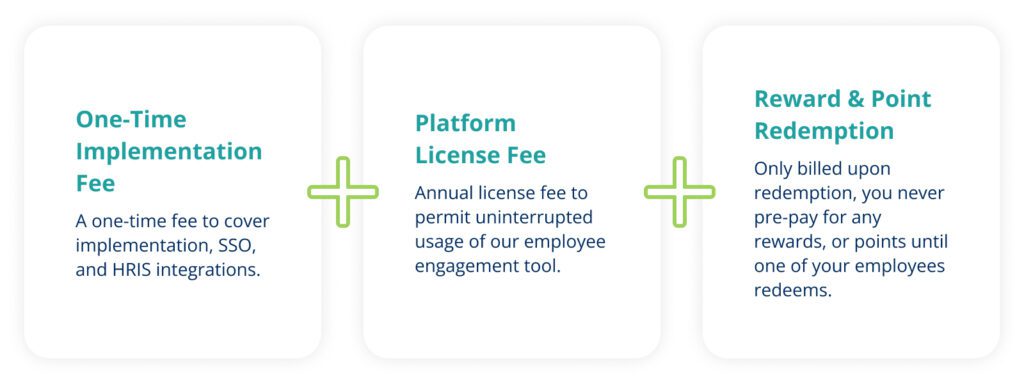
Schedule your personalized demo to learn more.
2. vi by Aderant
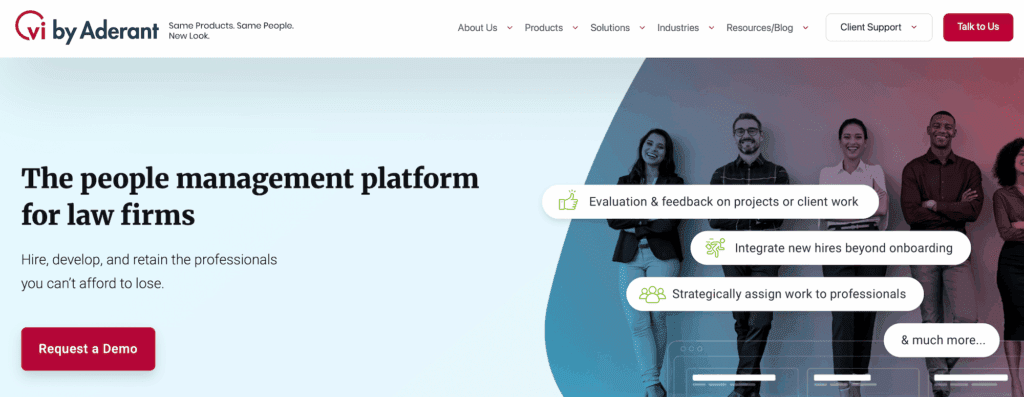
Vi by Aderant is an extensive people management software platform used by over 90% of Am Law 100 firms, featuring tools for recruiting, onboarding, new hire integration, career planning, performance management, learning and development, skills-based training, and more. The platform’s product suite includes:
- Recruitment and employee integration tools: viRecruit automates application intake, supports applicant tracking, handles interview scheduling, tracks candidate communication, and provides hiring analytics to speed and standardise recruiting. These tools can help you hire best-fit candidates and make them feel at home, reducing new-hire turnover.
- Performance management: viRTF (request, track, feedback) allows engaged employees to quickly request feedback from their managers, including course-specific coaching. You can review real-time feedback by employee, department, office, or practice group and track volumes, trends, and performance.Meanwhile, the evaluation software (viEval) uses an intelligent builder to assist you in designing a customized performance evaluation workflow for your firm, with options to rate performance by competencies (e.g., client and practice skills) and performance factors (e.g., oral communication or research and analysis.
- Learning and professional development: viLMS CLE offers a range of learning options, including self-guided courses and those tailored to individual goals and current skills. You can design structured learning paths for different seniority levels, such as junior and mid-level, or specific departments and roles, like litigation assistants. viSkills lets you build a repository of the skills employees need to progress, create processes for developing these skills, and track progress.
3. PerformYard
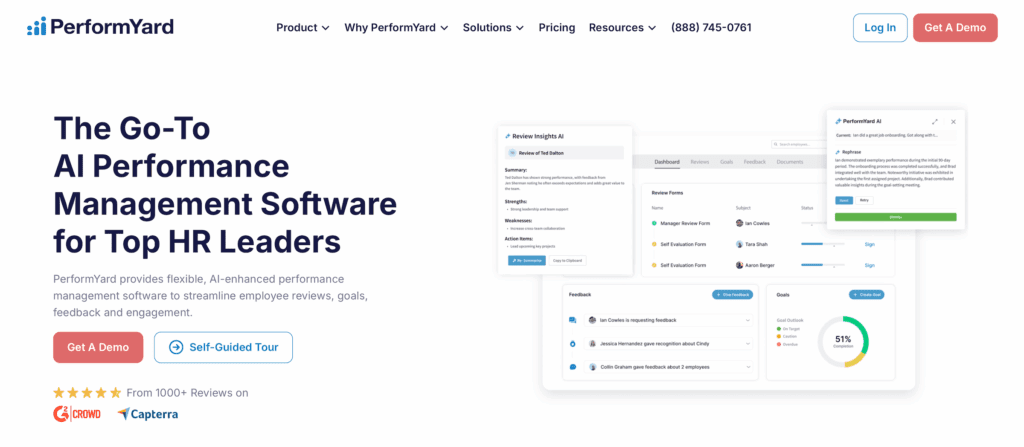
As its name suggests, PerformYard is a dedicated performance management system that services several industries, including legal, accounting, consulting, software, and marketing. The platform helps law firms save time and improve employee engagement with:
- Review processes tailored to individual roles: Evaluators can add goals (and their completion) to the performance review process, track progress, and share direct feedback. PerformYard also supports multi-reviewer processes to provide legal talent with different perspectives on their performance.
- Case-based evaluations for associates: You can tie evaluations to case completion and match the review cycle’s frequency with associates’ progress.
- Powerful reporting and analytics functionality: This allows you to track performance data and results across teams, job titles, departments, and any other dimensions. PerformYard stores employees’ collective performance history—qualitative and quantitative—providing a comprehensive view of their performance over time.
4. Litera
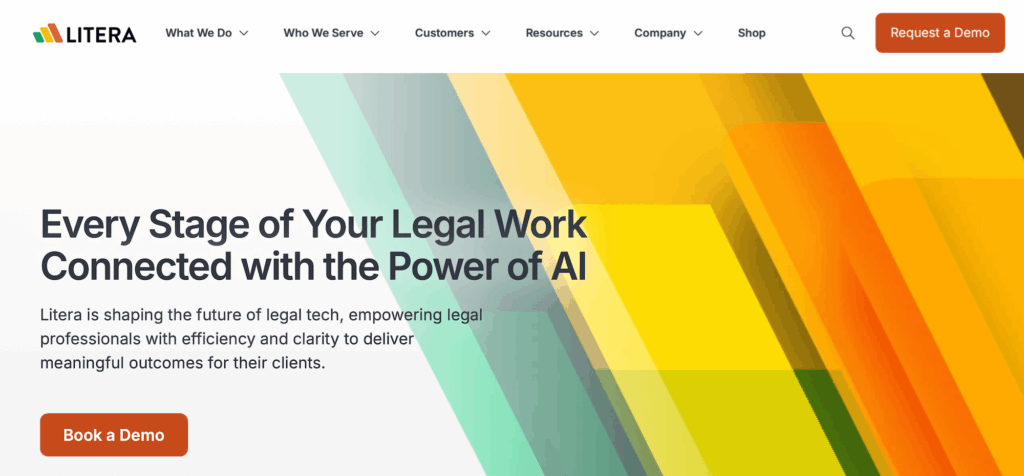
Litera offers a suite of products for legal practices of all sizes, including
- Legal talent management tools for recruiting, learning management, CLE tracking, and performance management, designed to reduce administrative work and improve governance across offices and jurisdictions. The platform offers an applicant tracking system (ATS), recruitment workflows tailored to the legal industry, structured performance evaluation tools, and more.
- Document drafting tools to reduce risk and improve the quality and accuracy of your legal documents. Litera Draft includes a library of enterprise-approved templates, secure file sharing, and AI-powered proofing and document repair.
- Contract review software powered by machine learning and AI, offering quick and valuable insights, exportable summaries, intelligent recommendations, progress tracking, version control, search features, and straightforward exporting features.
- A knowledge management suite that integrates institutional work products and client data into one searchable system so lawyers can reuse precedents, surface firmwide experience, and make faster, evidence‑based decisions. For example, the system extracts deal points and clause data from documents, turning them into searchable market insights, and provides genAI-driven search and answer tools.
Litera also offers various finance and marketing & business development tools, including a native CRM.
5. BigHand
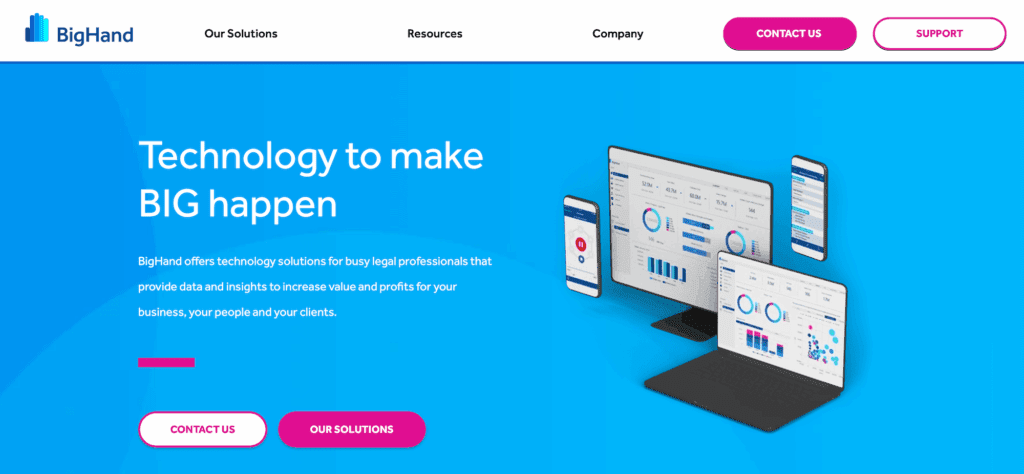
BigHand is a Litera competitor with its own suite of software solutions for law firms, including tools for people productivity, document and business productivity, and financial management and reporting capabilities.
BigHand’s resource management features can support your broader engagement strategy by providing managers with visibility into their team’s schedules and capacity before they assign work, helping them balance workloads effectively.
BigHand also helps you make smart resourcing decisions by providing a searchable view of lawyer skills, sector knowledge, existing relationships, and languages—ensuring people are assigned work based on merit. The platform’s various productivity tools help employees streamline day-to-day work, automating repetitive tasks and making their work more enjoyable.
Cultivate Your Firm’s Culture and Boost Retention with Terryberry
Law firms use Terryberry’s all-in-one employee engagement software to measure and benchmark employee engagement, forecast churn, and take action with tailored engagement programs. Terryberry helps you:
- Uncover trends in employee engagement and retention across cohorts, and investigate the underlying causes.
- Emphasize performance, core values, teamwork, and well-being with tailored programs.
- Track your program’s impact on employee engagement and retention, and create leadership-ready reports that demonstrate ROI.
Ready to boost engagement and retention? Request a personalized demo of Terryberry today.
